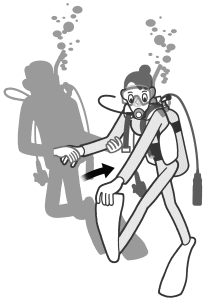 Dealing With Emergencies 1 Dealing With Emergencies 1
|
|
■Leg Cramps
Cramping is common due to factors like sudden exercise and cold from cold water, so warming up and wearing appropriate dive wear are the first line of defense. If you develop cramps, massaging the affected muscle is very effective. Afterwards, trying a different kick style and speed will help prevent a reoccurrence. |

Grab your fin tip and stretch your leg muscles. |
|
■Panic
If you let small troubles and worries affect you too much, increased respiration and heart rate will lead to breathing problems and a loss of self-control. In that case, stop, take hold of something like a rock, and breathe slowly to calm yourself down. |
|
■Octopus Breathing
Hold onto each other with your right hand (you’ll need your left for BC control). Keep eye contact, receive the octopus, and slowly and safely ascend to the water’s surface. If the dive buddy uses the Air 2 or similar combined octopus/inflator-type of equipment, you receive the regulator and your buddy switches to the combined octopus/inflator. |

|

|
In the case of a combined octopus/inflator |
In the case of a combined octopus/inflator (on the left) |
|
|
■Pony Bottle
Generally used near the water’s surface, having a pony bottle is not an excuse for poor air monitoring, since the amount of air available is small. If your dive buddy has an out-of-air emergency, you can hand off the bottle and slowly and safely ascend to the surface in sync, but there is no need to hold on to each other in this case. |

